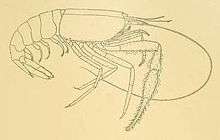Typhlocaris galilea
| Typhlocaris galilea | |
|---|---|
 | |
| Male. Plate from Calman, 1909 | |
| Scientific classification | |
| Kingdom: | Animalia |
| Phylum: | Arthropoda |
| Subphylum: | Crustacea |
| Class: | Malacostraca |
| Order: | Decapoda |
| Infraorder: | Caridea |
| Family: | Typhlocarididae |
| Genus: | Typhlocaris |
| Species: | T. galilea |
| Binomial name | |
| Typhlocaris galilea Calman, 1909 | |
Typhlocaris galilea is a species of troglobitic shrimp in the genus Typhlocaris, and is endemic to one pool and spring that feeds it, at Tabgha in Israel. The species is critically endangered and a conservation programme has begun.
Description
The relict[1] species was first described in 1909, by William Thomas Calman.[2]
The shrimp are semi-transparent and blind.[3] Adult specimens are approximately 3 inches (7.6 cm) long.[3] Their diet probably consists mainly of a small red tubificid worm, Isochaeta israelis.[4]
Distribution
The shrimp is endemic to one chamber of a Roman cistern, Ein-Nur octagonal pool (the private property of a monastery,[1] at 32°52′25″N 35°32′57″E / 32.8736°N 35.5493°ECoordinates: 32°52′25″N 35°32′57″E / 32.8736°N 35.5493°E), and a warm (27 °C or 81 °F),[5] sulphuric,[5] saline[1] subterranean spring that feeds it, at Tabgha,[6] on the north shore of the Sea of Galilee in Israel.[3][7]
Conservation
The species is now critically endangered, as the extraction of ground water has allowed foreign water into the pool, changing its composition and temperature.[3] It is legally protected (Section 5, paragraphs D and E, of the Fisheries Rules of 1937 as amended).[8]
In 2013, the Israel Nature and Parks Authority approached the Jerusalem Biblical Zoo to develop a captive breeding programme for the species, with a view to later reintroduction.[3]
References
- 1 2 3 Henk K. Mienis. "Rediscovery of Heleobia annandalei in the Octogon pool of Tabgha, Israel" (PDF). Tentacle. IUCN/SSC Mollusc Specialist Group. Retrieved May 7, 2013.
- ↑ W. T. Calman (1909). "On a blind Prawn from the Sea of Galilee (Typhlocaris galilea, g. et sp. n.)". Transactions of the Linnean Society of London. 2nd ser., Zoology. 11 (5): 93–97. doi:10.1111/j.1096-3642.1909.tb00194.x.
- 1 2 3 4 5 Karin Kloosterman (May 6, 2013). "Blind shrimp spared from extinction at Bible Zoo in Jerusalem". Green Prophet. Retrieved May 6, 2013.
- ↑ Moshe Tsurnamal & Francis Dov Por (1971). "The subterranean fauna associated with the blind palaemonid prawn Typhlocaris galilea Calman" (PDF). International Journal of Speleology. 3 (3/4): 219–223. doi:10.5038/1827-806x.3.3.3. Archived from the original (PDF) on 2014-03-22.
- 1 2 Rivka Gonen (2000). Biblical Holy Places: an Illustrated Guide. Paulist Press. ISBN 080913974X.
- ↑ M. Tsurnamal. "Temperature preference of the blind prawn, Typhlocaris galilea Calman (Decapoda, Caridea)". Crustaceana. 34 (3): 225–234. doi:10.1163/156854078x00781. JSTOR 20103277.
- ↑ M. Tsurnamal (1978). "The biology and ecology of the blind prawn, Typhlocaris galilea Calman (Decapoda, Caridea)". Crustaceana. 34 (2): 195–213. doi:10.1163/156854078X00736. JSTOR 20103268.
- ↑ "Legal analysis of the measures adopted by Mediterranean coastal states to minimize the impact of fishing activities on marine ecosystems and non-target species" (PDF). Regional Activity Centre for Specially Protected Areas. 2003. Retrieved May 7, 2013.
Further reading
- Annandale, N. (1912). "The blind prawn of Galilee". Nature. 90 (2244): 251. Bibcode:1912Natur..90..251A. doi:10.1038/090251a0.
External links
| Wikimedia Commons has media related to Typhlocaris galilea. |
- Charles Fransen (2013). "Typhlocaris galilea Calman, 1909". World Register of Marine Species.
See also
- Ayyalon Cave - a similar ecological niche where a related species lives